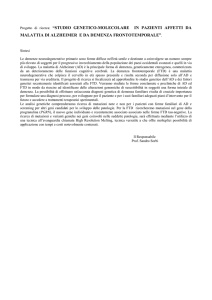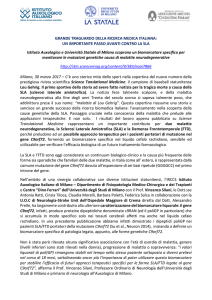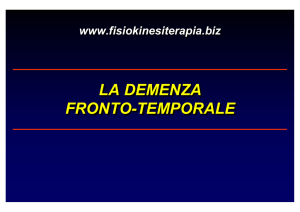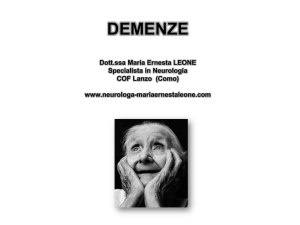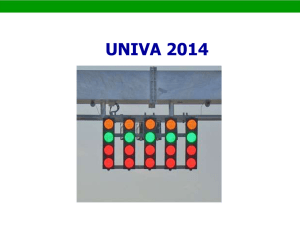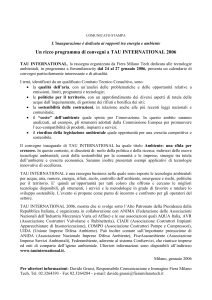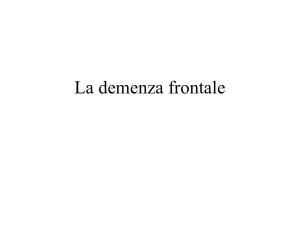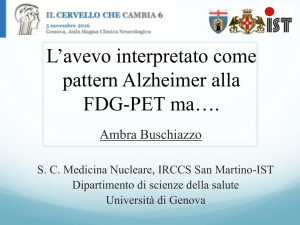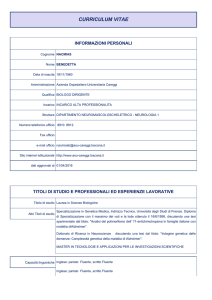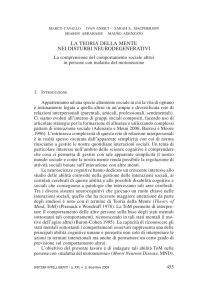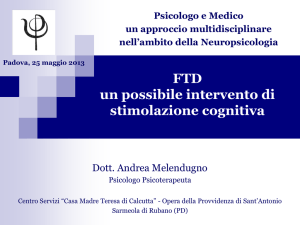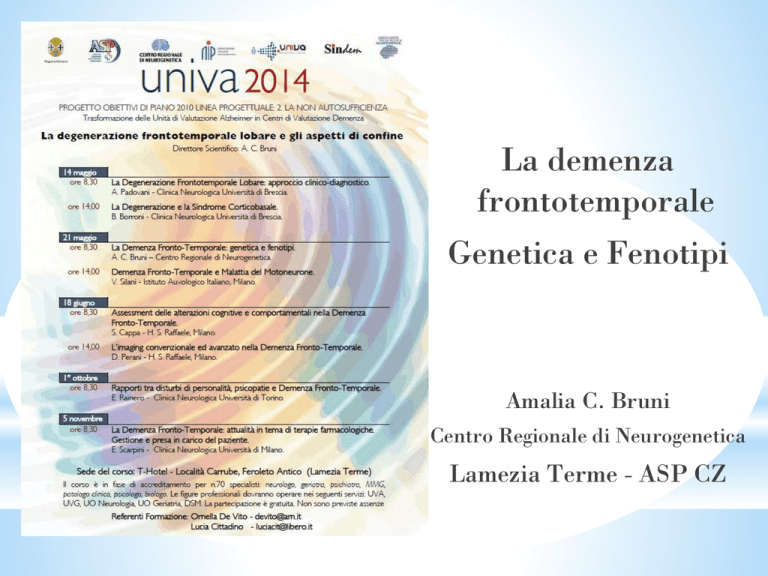
La demenza
frontotemporale
Genetica e Fenotipi
Amalia C. Bruni
Centro Regionale di Neurogenetica
Lamezia Terme - ASP CZ
*Frontotemporal dementia
Complex disorder
Clinically
Neuropathologically
Genetically
Several phenotypes
Heterogeneous
*
*
*
*
*
*
*
*
*
*
*
*
*
*
*
*
*
1892: Arnold Pick describes lobar atrophy in a patient with presenile dementia and aphasia.145
1911: Alois Alzheimer characterizes Pick bodies using silver stains.146
1960’s: descriptions of PSP and CBD clinicopathological syndromes.147,148
1974: different pathological subtypes of PiD disease described.149
mid 1980’s - early 1990’s: identification of tau as major component of pathological lesions in AD, PiD, PSP
and CBD (reviewed in Lee et al.).150
1990: description of FTD cases without specific histopathology (DLDH).151
mid 1990’s: identification of subset of FTD with FTLD-U pathology.152
1998: MAPT mutations identified in some families with FTD and parkinsonism genetically linked to
chromosome 17.10–12
2004–06: recognition that most cases of DLDH are really FTLD-U and that FTLD-U is the most common
FTD-associated pathology.33
2006: description of different patterns of FTLD-U that correlate with clinical phenotypes, genetic
abnormalities and biochemical properties of inclusions.115,117
2006: discovery that GRN mutations cause autosomal dominant FTD and explain all remaining chromosome
17 linked families.14,15
2006: TDP-43 identified as pathological protein in most cases of FTLD-U and ALS.34,35
2008: identification of a subset of FTLD-U cases that lack TDP-43-immunoreactive pathology (aFTLDU).153,154
2009: discovery that most cases of tau/TDP-43-negative FTLD have FUS-immunoreactive pathology (FTLDFUS).38–40
2011: discovery that FTLD-FUS shows accumulation of other FET protein members TAF15 and EWS.41
2011: FTD/ALS associated gene defect on chromosome 9p identified as repeat expansion in C9ORF72.27,28
*FTD Epidemiology
*Second most common type
of presenile dementia (now
several cases described
>80)
*Positive family history in
up to 50% of cases (mainly
autosomal dominant)
Literature
*Andreasen, 1999 (Swedish):
3.2%
*Ratnavalli et al 2002
(Cambridge study): 15.7%
*Harvey et al, 2003 London
study 12%
*FTD Prevalence 0.02%
*Ikeda et al 2004 (Japan
study) 12.7%
*Sex distribution
*Age at onset
*Duration (yrs)
*Prevalence
*Familial history
*Symptoms at onset
*Cognitive features
*Neurological signs
*Neuroimaging
*
Neary et al 2005
1:1
45-65 (range 21- 85)
6-8 (3 with MND)
15/100.000
50%
Behavioral changes
Executive and language
deficits
Parkinsonism / MND
FT abnormalities
DEMENTIA CASES 1997-2012
Early
Early
Late
Total
Sporadic
363
1177
1540
Familial
459
951
1410
Autosomal
dominant
27
17
44
Total
849
2145
2994
Late
AD
Early
Late
FTD
Early
1997-2012
2997 DEMENTIA CASES
Late
ESTIMATING THE INHERITANCE OF FRONTOTEMPORAL
LOBAR DEGENERATION IN THE ITALIAN POPULATION
* EO-FTD 86.3%
* (95% CI: 77.0%-95.0%)
* Hereditability LO-FTD
75.7%
(95% CI: 65.0%-86.0%).
Borroni B, Grassi M, Bianchi M, Bruni AC, Maletta RG, Anfossi M, Pepe D, Cagnin A, Caffarra P, Cappa S, Clerici F, Daniele A, Frisoni
GB, Galimberti D, Parnetti L, Perri R, Rainero I, Tremolizzo L, Turla M, Zanetti O, Padovani A.
J Alzheimers Dis. 2013 May 29. [Epub ahead of print]
One Disease Multiple Genes
TA Manolio et al. Nature 461, 747-753 (2009) doi:10.1038/nature08494
*
Demenza
frontotemporale
Malattia di
Alzheimer
onset
onset
Disturbi
cognitivi
Disturbi
comportamentali
11
12
*
* Frontotemporal Dementia-Behavioral Variant (FTD-BV)
* Pick’s Disease (PD)
* Semantic Dementia (SD)
* Primary Progressive non-fluent aphasia (PPA)
* Cortico-Basal Syndrome (CBS)
* Progressive Sopranuclear Palsy (PSP)
* FTD-MotorNeuron Disease (FTD-MND)
FTLD
Core Features
Brain topography
Clinical syndrome
Kumar-Singh S. and Van Broeckhoven C. (2007) Frontotemporal Lobar Degeneration:
Current Concepts in the Light of Recent Advances Brain Patho 17:104–113.
*FTLD
GENES
#Mutations #Proteins
genes /proteins
# Families
#Inclusions
#Phenotype
MAPT
44
Microtubule
network
132
Tau inclusions
FTD-bv FTDP
GRN
69
Growt factor
231
Ub/TDP-43 inclusions
FTD-bv-SD-PPA
CBS
VCP
17
Vesicle transport
41
Ub/VCP inclusions
IBMPFD -ALS
CHMP2B
4
Endosomal
trafficking
5
Ub inclusions
ALS-FTD
92
TDP-43 inclusions
34
DNA binding
/regulating protein
ALS- rarely
FTDbv
49
FUS inclusions
23
DNA binding
Regulating protein
ALS – rarely
FTDbv
1
Unknown
336
Ub inclusions
ALS-FTD / FTD/
ALS
TAR-TDP
FUS
C9ORF72
AD&FTD
Mutation
database
22/08/2011
AD&FTD
Mutation
database
20/09/2013
Frontotemporal dementia and
Parkinsonism
linked to chromosome 17
Missense or splice site mutations
in Mapt gene cause FTDP-17
4R/3R Altered ratio
Foster NL, Wilhelmsen K, Sima AAF, Jones MZ, D'Amato C, Gilman S, Conference
Participants (1997) Frontotemporal Dementia and Parkinsonism linked to chromosome 17:
A consensus statement. Ann Neurol 41:706-715.
* Clinical features of tauopathies
* Onset = <30 <50
* Duration <5 years < 15
* First signs: Parkinsonism
Dementia
* Personality change
* Language difficulties
* Eye mouvements
abnormalities
* Epilepsy
* Myoclonus
* Pyramidal signs
* Amiotrophy
Clinical duration and clinical category of FTD is shown as a coloured bar in GRN mutation
carriers (GRN-positive), MAPT mutation carriers (MAPT-positive) and wild-type GRN FTLD-U
Tau immunohistochemistry
Most severely affected areas: frontal
lobe, including motor cortex,
supramarginal G.
Beck, J. et al. Brain 2008 131:706-720; doi:10.1093/brain/awm320
*
*
*
*
The same mutation could be associated to different
phenotipes ..i.e. MAPt P301S variability
FTD phenotype and corticobasal
degeneration in the same family (Bugiani
et al 1999)
Parkinsonism and epileptic seizures
(Sparked, 1999)
Parkinsonism followed by cognitive
impairment (Kawamata, 2005)
Bugiani O, Murrell JR, Giaccone G et al. (1999) Frontotemporal dementia and corticobasal degeneration in a family with a P301S mutation in tau.
J Neuropathol Exp Neurol. 58(6):667-77.
Sperfeld AD, Collatz MB, Baier H et al. (1999) FTDP-17: an early-onset phenotype with parkinsonism and epileptic seizures caused by a novel mutation.
Ann Neurol. 46(5):708-15. Kawamata T et al. (2005) Phenotypic heterogeneity within a new family with the MAPT P301S mutation. Ann Neurol.
58(6):920-8.
RB Family, ascertained 1989
onset 50.0+3.4
death 53.0+7.5
Memory impairment, troubles of language, disorientation,
troubles of behaviour and personality,apathy, lack of personal and
social awareness, delusions, hallucinations
psychomotor agitation, aggressivity and violence.
Extrapyramidal signs rigidity, amimia, supraspinal signs. No tremor,
Epilepsia, myoclonus
Pul family
onset 47.5+0.7
death 55.5+6.4
# 133546 Lives in Milan
Onset 46. Uninterested in home
management, disinhibited.
Insight absent . Frequent collapse,
agitatated, disoriented.
After 6 yrs mutacic but able to sing
old songs, echolalia, wandering.
After 8 yrs completely mute,
aggressive, bulimic, fatuous
expression. Diagnosis FTD
#133548 Lives in Turin onset 48.
Language poor and stereotypic,
childish, cognitive troubles
(concentration, abstraction and
planning deficits) but spatially
oriented, insight absent. No delusions
Diagnosis AD
*
Haplotype analysis on families RB and Pul having the same
MAPT mutation (Pro301Leu)
Marker (~ position)
(RB Family)
778
(Pul. Family)
2729
D17S951 (39 Mb)
1
3
4
5
D17S579 (40 Mb)
1
3
1
2
D17S920 (42 Mb)
1
3
1
3
D17S806 (43 Mb)
1
3
1
1
MAPT
(41 MB)
(D17S951) is different: it is possible that a single recombination event has occurred in this region.
* Intrafamilial clinical variability in
* pathologically-proven Frontotemporal dementia and parkinsonism
* linked to chromosome 17 (FTDP-17) caused by MAPT-P301L mutation.
SINDEM
2012
*
*
*
*
* Inserire slide nostre di
P301L
Tau-immunoreactive (AT8-ir) changes in the neuropil: neurofibrillary tangles (NFT) in the
perikaria of neurons (Fig.5), Pick bodies (Fig.6), and meshwork of neuropil threads (Fig.7).
Significant tau-immunoreactivity in the glial cells in the form of coiled bodies in
oligodendrocytes (Fig.8, AT8-ir; black arrow) and star-like tufted astrocytes (Fig.9, AT8-ir) with
marked reactive astrogliosis in the neuropil and around vessel walls (Fig.10, GFAP-ir).
Spinal motoneurons were greatly involved (Fig.11, AT8-ir); in the cerebellum, rare NFT were
present in the dentate nucleus (Fig.12, AT8-ir) but cerebellar hemispheres were spared.
Familial Semantic Dementia with P301L Mutation
in the Tau Gene
Semantic dementia (SD) is a clinical subclassification of frontotemporal lobar degeneration. Patients with
'pure SD' present with semantic memory impairment preceding the frontal symptoms, and there have been
no reports of familial cases.
Methods: We evaluated the clinical features of, and performed neuropsychological examinations on, the
proband and two affected family members. Then we performed neuroimaging and genetic analysis of
MAPT and other dementia-related genes in the proband.
Results: All three cases had semantic memory impairment with loss of word meanings as
the primary early symptom. We diagnosed all cases as pure SD and identified a P301L
mutation in the MAPT gene of the proband.
Conclusion: Although the P301L mutation identified here has been previously described as pathogenic for
frontotemporal dementia with parkinsonism-17 (FTDP-17), the proband and his two affected relatives
showed different clinical symptoms from those of typical FTDP-17 cases who carry the P301L mutation.
Pathologically, pure SD usually shows a TAR DNA-binding protein proteinopathy, but the molecular
understanding of SD is not well established. Although our cases were clinically pure SD, the proband has a
tau gene mutation, which would lead to tauopathy. These findings suggest that reconsideration of the
molecular understanding of SD is warranted
Ishikuza et al Dement Geriatr Cogni Disord 2011;31(5):334-40. Epub 2011 May 10.
Onset 56, she presented with hallucinations and progressive
personality changes, became disinhibited with inappropriate jocularity;
touching everything and everyone; stopping people on the road telling that
she was seeing angels . At 56 she was untestable gradually progressed to
complete mutism. Death occurred at 61
MAPT V363I mutation in a sporadic case of frontotemporal dementia
rs9897526
rs9897526
rs9897526
rs9897526
rs9897526
rs9897526
Phenotypes associated to +3
MSTD
Parkinsonism, frontal lobe signs,
incontinence, dysphagia, dizziness
and signs of upper and/or lower
motor neuron dysfunction. Eye
movement abnormalities, sleep
disturbance and paresthesias less
common
PSP
Severe compromission of postural
reflexes
Isolated memory deficit
Anti4RTau
Mutations in the MAPT gene
+4
Van Swieten J. and Spillantini M.G. (2007) Hereditary Frontotemporal Dementia Caused by Tau Gene
Mutations. Brain Pathol 17:63–73.11
Brain weighted 650 gr. Massive atrophy of
the frontal temporal lobes with relative
sparing of Rolandic and calcarine regions
1
Severe atrophy of the caudate nucleus and of
white matter (fig 2) Hippocampus was
destroyed (fig 3, H&E).
1
2
3
bar
3R
4R
Morphological aspect of tau
labelling:
A: Neurofibrillary tangles
(arrow) immunolabelled by
antibody against 3 R tau.
B: Pick body like inclusion
stained by a polyclonal antitau
antibody.
C: Astrocytic inclusion
D: Coiled body in the white
matter
E and F: comparison of the same
region immunolabelled by an
antibody against 3R Tau (E) and
against 4R Tau (F).
3R labels tangles (black arrow);
a perinuclear ring is sometimes
also visible. The
immunolabelling obtained with
4R tau is weak or absent.
*
Brain tissue
A
FDUb
F
T
P
O
C
MW
500bp
Tau4R
Tau3R
9
10 11 12
9
11 12
Bands corresponding
to the 3R transcripts
are much stronger than
4R
In vitro
FDUb
I-1
I-2
II-1
MW
500bp
E10+
E10-
9
10
11
9
11
Patient’s parents (I-1; I-2)
3R/4R ratio
altered in II-1
Brain Tissue Study
Tau Analysis
Immunoblot analysis of Sarkosyl-insoluble tau:
detection of increased levels of 3RTau isoforms
Index
Brain
BR134
lPPase
-
AD
+
τ68
τ64
τ60
4R2N
3R2N
4R1N
3R1N
4R0N
3R0N
AT8
AT100
BR134
12E8
Pick bodies are negative for 12E8
BR134: phosphorylation-independent anti-tau antibody
AT8, AT100 e12E8: phosphorylation-dependent antibodies
Recombinant
tau mix
Brain Tissue Study
Tau Analysis
Immunoblot analysis of soluble tau:
detection of increased levels of 3RTau isoforms
AD brain
Index brain
lPPase
-
-
+
4R2N
3R2N
4R1N
3R1N
4R0N
3R0N
BR134
BR134
+
Comments
Generally intronic mutations affecting tau splicing leads
to 4Rtau
In our case the increase of 3R0N is probably caused by
the interaction of the two mutations with unknown
mechanisms (other splicing factors?)
This compound heterozigous case reinforces the notion
that sporadic cases can be caused by genetic mutations
2
a
* Onset 46. Progressive
personality changes,
memory loss, strong
reduction of verbal fluency
evolving to complete
mutism,
* behavioural stereotypies,
episodic myoclonus, urinary
incontinence, hyperorality.
* No amyotrophy. Death at 57.
8
9
1
10
11
12
Morphological aspect of tau labelling:
A: Neurofibrillary tangles (arrow)
immunolabelled by antibody against 3 R
tau.
B: Pick body like inclusion stained by a
polyclonal antitau antibody.
C: Astrocytic inclusion
D: Coiled body in the white matter
E and F: comparison of the same region
immunolabelled by an antibody against
3R Tau (E) and against 4R Tau (F).
3R labels tangles (black arrow); a
perinuclear ring is sometimes also visible.
The immunolabelling obtained with 4R
tau is weak or absent.
3R
Scale bar = 20 µm for all pictures.
4R
Onset 56, she presented with hallucinations and progressive
personality changes, became disinhibited with inappropriate jocularity;
touching everything and everyone; stopping people on the road telling that
she was seeing angels . At 56 she was untestable gradually progressed to
complete mutism. Death occurred at 61
MAPT V363I mutation in a sporadic case of frontotemporal dementia
rs9897526
rs9897526
rs9897526
rs9897526
rs9897526
rs9897526
PGRN GENE
PGRN GENE
Pathogenic mechanism
Haploinsufficiency
Mutations cause a premature
termination Codon that leads to
nonsense –mediated mRNA decay.
This functionally NULL ALLELE
reduces PGRN expression by 50%
Bhandari et al., 1993; Daniel et al., 2000,Bateman and Bennett, 1998; He and Bateman, 2003; Ahmed et al., 2007
)
PGRN is NOT
incorporated
into UBI+ inclusions
in FTLD-Ubi
Mutations in the progranulin gene (PGRN), on chromosome
17q21, have been identified as a major cause of familial
frontotemporal dementia (FTD). These cases have a
characteristic pattern of neuropathology that is a distinct
subtype of frontotemporal lobar degeneration with
ubiquitinated inclusions (FTLD-U). There is no abnormal
accumulation of PGRN protein in the brain and
immunohistochemical and biochemical analysis indicates that
the ubiquitinated pathological protein is TDP-43.
The neuropathology and clinical phenotype of FTD with progranulin mutations
MacKenzie J Acta Neuropathol. 2007 Jul;114(1):49-54. Epub 2007
*
Nuclear protein involved with the regulation of DNA
expression NORMALLY contained in the nucleus, in diseased
neurones leaves the nucleus and accumulates in cellular
bodies
Permission from G. Giaccone
*
Clinical duration and clinical category of FTD is shown as a coloured bar in GRN mutation
carriers (GRN-positive), MAPT mutation carriers (MAPT-positive) and wild-type GRN FTLD-U
Beck, J. et al. Brain 2008 131:706-720; doi:10.1093/brain/awm320
Copyright restrictions may apply.
Lancet Neurol 2008
Hereditary FTD
variant
Prevalence
in FTD
Number of
mutations
Age at onset (years)
Clinical presentation
Neuropathology
MAPT mutations
5-15%
>40
25-65
Behavioural changes, cognitive
dysfunction, and parkininsonism
(progressive supranuclear palsy,
corticobasal syndrome)
Neuronal and glial
tau-positive
inclusions
VCP mutations
Rare
8
48-65
Inclusion body myositis, Paget’s
disease, behavioural changes,
and cognitive dysfunction
Ubiquitin-positive
and TARDBPpositive NII and
dystrophic neurites
CHMP2B mutation
Rare
5
>50
Behavioural changes, cognitive
dysfunction, extrapyramidal
features, and motor neuron
disease
Ubiquitin-positive,
p62-positive and
TARBP-negative
NCI
GRN mutations
>5-15%
>50
35-89
FTD, Alzheimer’s disease,
corticobasal syndrome, and
parkinsonism
Ubiquitin-positive,
TARDBP-positive
NCI, NII, and
dystrophic neurites
Chromosome 9linked FTD
Unknown
Unknown
39-72
Motor neuron disease,
behavioural changes, and
cognitive dysfunction
Ubiquitin-positive,
TARDBP-positive
NCI, and glial
inclusions
FTD= frontotemporal dementia. NCI = neuronal cytoplasmic inclusions. NII = neuronal intranuclear inclusions.
Table: Demographic, clinical, and pathological features of hereditary FTD with MAPT, VCP, CHMP2B, GRN gene mutations, and FTD and
motor neuron disease linked chromosome 9
Onset 61 Playful and moriatic,
alteration of eating behavior.
Within 3 yrs apathetic,
reduction of verbal fluency.
At 69 mute, incontinent,
completely dependent.
* mutazione GRN – CYS139ARG
*
Bivongi
Biv… Family
t negative – Chrom 3 and 9 (linkage) negative
1666
7166
1764
1767
3486
4387
110
8322
1766
1373
3178
8301
8299
8300
8311
8292
1553
1971
3187
2005
5496
2972
5497
8323
9083
1609
1641
1625
1631
1617
2083
3001
1642
1271
1272
1241
1242
2045
1275
2749
2062
5471
3119
1323
1343
3121
2869
5578
2061
1324
5572
5498
5472
onset 63.8 +11.6 (40-78)
death 67.0 +10.5 (44-80)
1665
1610
1969
3492
8302
1664
7165
1765
1771
1667
1282
2499
5573
1283
1394
2871
2506
4509
4036
4514
5569
9082
9085
5470
206
14
16
8
5577
5571
5570
207
2507
32
3
9
33
2
5473
5474
5596
5568
5599
5600
5601
359
1
23
26
15
22
21
47
24
55
25
28
56
474
472
476
* Symptoms in the first year
12
10
11
10
9
8
8
8
Pazienti
6
4
2
0
Apathy
Lack of critic
and
judgment
Loss of
Loss of
personal insight social rules
Disinhibition
Symptoms in the second year
11
10
Pazienti
8
10
10
8
6
4
2
0
Stereotipie e
Incapacità di
perseverazioni
astrazione
Deficit attenzione
Rid. iniziativa
verbale
c1,145insA
Mean onset 65.1+17.1 (35-87)
APOE, tau, or TMEM106B genotypes do not modify
the age-at-onset in carriers of the mutation
phenocopies
Neurology, 2007, 69, 140-147
Bivongi
100
*
Questionnaire for demographic
and social data (WHO-QOL)
*
Anamnestic record compiled by
family phisician
*
MMSE, ADL, IADL , verbal
fluency
*
(phonological and for
categories)
*
Biochemistry; DNA analyses
90
80
46
70
60
46
42
50
41
28
40
30
19
22
18
46
20
34
29
10
21
33
25
18
15
14
6
3
0
50-54
55-59
60-64
65-69
70-74
Maschi
75-79
Femmine
*
80-84
85-89
90-94
3
95-99
* 92
subjects selected for II step
35
32
30
29 soggetti con demenza
25
23
20
16
15
10
6
5
0
N
or
m
1
D
al
i
2
1
ep
re
ss
i
Ic
tu
on
e
C
s
3
3
3
1
1D
M
D
is
Pa
i
D
l
er
em
tu
Pa
A
d
em
rk
FT
lz
eb
C
rb
rk
en
i
he
n
og
e
D
ro
id
in
s
n
z
i
o
m
a
va
za
ni
el
so
n
v
t
e
sc
iv
di
co
n
D
r
as
e
em
ul
N
m
co
Im
op
D
po
en
la
D
pa
at
re
rt
za
irm
ie
am
en
en
t
to
Age (yrs)
Men
Women
Total
N
%
N
%
N
%
50-59
0
-
0
-
0
-
60-69
0
-
1
1.6
1
0.9
70-79
8
10.0
9
9.8
17
9.9
80-89
4
8.3
6
10.0
10
9.3
90-99
0
-
1
5.0
1
3.8
12
5.3
17
6.0
29
5.7
Dementia
Total
Age (yrs)
Men
Women
Total
N
Pr %
N
Pr %
N
Pr %
50-59
0
-
0
-
0
-
60-69
0
-
1
1.6
1
0.9
70-79
2
2.5
4
4.3
6
3.5
80-89
3
6.3
5
8.3
8
7.4
90-99
0
-
1
5.0
1
3.8
5
2.2
11
3.9
16
3.1
3
0.6
3
0.6
6
1.2
1
0.2
Frontotemporal dementia
Total
Alzheimer
Total >50 yrs
Vascular dementia
Totol >50 yrs
Unspecified dementia
Total >50 yrs
Parkinson dementia
Total >50 yrs
FTD patients identified through the door to door survey
Prevalence
55.2% of dementing
patients has FTD
Prevalence rate of FTD is
3.1%
FTD is twofold common
in females than males
(11/5)
*
Mutazione INS
Media±Ds 64.3±14.3
Range 35-87
Quadro clinico
«comportamentale
• Disinibizione
• Perdita della
consapevolezza
sociale
• Distraibilità
• Perdita del
linguaggio
fino al mutismo
Mutazione ALA
Media±Ds 76±2.9
Range76-79
Quadro clinico
«affettivo»
• Apatia
• Indifferenza
emotiva e
affettiva
• Riduzione del
linguaggio ma
mai perdita
Mutazione CYS
Età di esordio
65-77
Quadro clinico
«delirante»
• Deliri
paranoidei
• Disinibizione
• Agitazione
phenocopy
*
c.1145insA
A266P
th
Link at the 7 generation
1700
c.1145insA
C126W
Phenocopies
Asymptomatic
carrier c.1145insA
h
Link at the 4t generation
1800
1900
+80
+80
*
Nell’area studiata la prevalenza delle demenze è uguale a quella in
tutte le parti del mondo (6%)
Tuttavia….
La demenza frontotemporale ha una prevalenza altissima e mai
riscontrata in altri parti del mondo.
Circa la metà dei casi identificati ha una causa genetica
Le mutazioni identificate causano la stessa malattia ma con varianti
cliniche. Una stessa mutazione da origine a casi con esordio a 50
anni e altri con esordio ad 87 !
La Malattia di Alzheimer è “praticamente assente” e non
abbiamo spiegazione per questo fenomeno
*Domanda
• Questi risultati sono
causati da un
ambiente
particolare???
• O da un substrato
genetico ancora
diverso?
* O da interazione geni
ambiente???
*
Studiare gli effetti di geni e ambiente.
1) Censire i Bivongesi emigrati
2) Identificare soggetti affetti da demenza in fase
conclamata o iniziale e diagnosticare la tipologia
3) Studio genetico molecolare
‘Tangles’ and ‘neuropile threads’,
visualised by silver staining and
antitau; better with ubiquitin
immunoreactivity. No plaques.
BAG FAMILY
Bag. Family
FTD
Probable FTD
SLA
1146
1147
1148
1149
FTD - SLA
Parkinson
1133
1131
1132
1150
+75
+78
+1993
1134
Parkinson??
+87
1138
Onset 49- 55
1139
1135
1136
1152
1125
1153
1126
1142
1143
Onset 48
+ 72
SLA
+51
1141
1151
1137
1140
1129
1128
1130
1127
1145
1144
*
GENI IDENTIFICATI
VCP- CHPM2B – TDP – FUS - C9ORF72
3-10%
ALS
Dementia
ALS - Dementia
*
Non solo in casi ereditari!!!
Majounie et al Lancet Neurol 2012
*
Zhengrui Xi, PhD; Lorne Zinman, MD; Yakov Grinberg, PhD;
Danielle Moreno, BSc; Christine Sato, MSc;
Juan M. Bilbao, MD; Mahdi Ghani, MD; Isabel Herna´ndez, MD;
Agustı´n Ruiz, MD, PhD; Mercè Boada, MD, PhD;
Francisco J. Moro´n, PhD; Anthony E. Lang, MD; Connie Marras,
MD, PhD; Amalia Bruni, MD; Rosanna Colao, MD;
Raffaele G. Maletta, MD; Gianfranco Puccio, MD; Innocenzo
Rainero, MD, PhD; Lorenzo Pinessi, MD;
Daniela Galimberti, PhD; Karen E. Morrison, PhD; Catriona
Moorby, BSc; Joanne D. Stockton, BSc;
Mario Masellis, MD; Sandra E. Black, MD; Lili-Naz Hazrati, MD;
Yan Liang, MD; Jan van Haersma de With, BSc;
Luis Fornazzari, MD; Roque Villagra, MD; Ricardo Rojas-Garcia,
MD, PhD; Jordi Clarimo´n, PhD;
Richard Mayeux, MD; Janice Robertson, PhD; Peter St GeorgeHyslop, MD, FRCP(C); Ekaterina Rogaeva, PhD
‘Tangles’ and ‘neuropile threads’,
visualised by silver staining and
antitau; better with ubiquitin
immunoreactivity. No plaques.
* Inclusioni Ubi+ p62+ in corteccia,
ippocampo e cervelletto
Ubi-ir
P62-ir
*
AD Braak V
Placche e deposti di
Abeta proteina
* Hippocampal sclerosis dementia with the C9ORF72 hexanucleotide repeat
expansion.
* Frontotemporal dementia (FTD) and amyotrophic lateral sclerosis (ALS)
are the main syndromes of the chromosome 9 ORF72 (C9ORF72)
….studies have shown a substantial phenotypic diversity that includes
psychiatric presentations. This study describes hippocampal sclerosis
dementia (HSD) in carriers of the C9ORF72 mutation. We compared
clinical and neuropathological features of HSD in carriers and
noncarriers autopsied at Johns Hopkins. Carriers presented with amnesia,
agitation, dissocial behavior, and impaired self-care, whereas noncarriers
showed little agitation.
* Neuropathological examination of carriers showed cerebellar neuronal
inclusions positive for ubiquitin, p62, and ubiquilin-2, and negative for
TAR DNA-binding protein 43. Noncarriers did not have cerebellar
inclusions. C9ORF72 repeat-associated non-ATG translation was
confirmed by immunohistochemistry. These observations broaden the
C9ORF72 phenotype and place HSD in the FTD spectrum. The amnesic
phenotype of HSD, which is consistent with the focal hippocampal
atrophy, should be included in clinical categorizations of FTD
* Pletnikova O1, et al 2014
*
Neurobiol Aging. 2014 Apr 18. pii: S0197-4580(14)00311-X. doi:
10.1016/j.neurobiolaging.2014.04.009. [Epub ahead of print]
Psychosomatics.
*
Khan BK
.
Psychosis and hallucinations in frontotemporal dementia with the C9ORF72
mutation: a detailed clinical cohort.
To specify the presenting symptoms and clinical course of patients with frontotemporal
dementia (FTD) and chromosome 9 open reading frame 72 (C9ORF72) repeat expansion.
BACKGROUND:
…….Prior reports identified a subset of patients with FTD who had an unusually high
prevalence of psychosis, although their specific symptoms had not yet been fully described.
METHODS:
From a cohort of 62 patients with FTD, we conducted a retrospective chart review of 7
patients who had C9ORF72 mutations on genetic testing, and 1 untested sibling of a
C9ORF72 carrier.
RESULTS:
Detailed histories revealed a higher prevalence of psychosis,
including visual
and auditory hallucinations and delusions, in the 8 C9ORF72 carriers
than in our patients with sporadic FTD.
CONCLUSIONS:
This cohort confirms and adds clinical details to the reports of a high prevalence of psychotic
phenomena in patients who have C9ORF72 mutations as well as FTD or amyotrophic lateral
sclerosis
Kertesz A1
Cogn Behav Neurol. 2013 Sep;26(3):146-54. doi: 10.1097/WNN.0000000000000008
*
C9ORF72 expansion in a family with
bipolar disorder.
Meisler et al 2013
C9ORF72
Grn
Early onset
Behav
dishinibited
If MND early
feature
bvFTd
avPPA
CBS
MAPT
Behav
ftd
Psychosis
Parkinsonism
*
Van Langenhove et al.JAMA Neurol. 70,
365–373 (2013).
* a 2-stage GWAS analyzing a total of 3,526 FTD
cases and 12,538
* controls with the aim of identifying
common/novel loci associated with the disease
*
Ferrari et al in press 2014 Lancet Neurology
*
*
n°87 centri coinvolti
87 Questionari analizzati
113 Professionisti coinvolti
Varese
•Castellanza H
•Circolo H
•AO Gallarate
Monza
Università degli Studi
Milano
•Policlinico
•Auxologico
•Pio X
•HSR Neurologia
•HSR Riabilitazione
•HSR Villeturro
•Ist. Besta
•IRCSS S.M.Nascente
Bergamo
• Humanitas
• Trescore
• Clinica S. Francesco
• Fond.Gusmini - Vertova
Brescia
•Università degli Studi
•S Anna H
•IRCSS Neuropsicologia
•IRCSS Genetica
•Vallecamonica
Verona
•Università degli Studi
•USLL20
Crema
Maggiore H
Venezia
Portogruaro H
Aosta
Aosta H
Mantova
• IRCCS Maugeri
• Poma H
Ferrara
AO Ferrara
Torino
Università degli Studi
Rimini
Rimini H
Reggio Emilia
S.Maria Nuova H
Pavia
• IUSS
• Mondino H (3)
Parma
• Università degli Studi
• Ausl Fidenza
Ancona
Riuniti H
Lucca
ASL Lucca
Pisa
AO Pisa
Perugia
Univesità degli Studi
Modena
•Civile H
•Ramazzini
Arezzo
Firenze
Università degli Studi AUSL 8 Arezzo
Roma
•Università Cattolica
•Università Sapienza
•Campus Biomedico
•Università Tor Vergata
•San Giovanni H
•Uva Sapienza
Bologna
•Univesità degli Studi
•S.Orsola H
•Bellaria H
Ascoli Piceno
San Benedetto del T. H
Chieti
Università degli Studi (2)
Foggia
•Riuniti H
•IRCSS
Bari
UVA Policlinico
USL Monopoli H
Napoli
Università degli Studi II
Sassari
• Distretto Sanitario
• AO Sassari
Nuoro
San Francesco H
Cagliari
• S.Trinità H
•Università degli Studi
Cosenza
UVA Trebisacce
Catanzaro
• Villa Gerani H
• Girfalco H
Lamezia T
Neurogenetica
Palermo
• Policlinico
• P.Giaccone H
Catania
Università degli Studi
Cefalù
San Raffaele H
La migliore conoscenza ed individuazione
Della FTD ci permetterà sempre meglio
di comprenderne i meccanismi patogenetici,
di individuare terapie adeguate e percorsi
Assistenziali specifici
* Comune di Bivongi
(Sindaci Valenti- Riggio)
* Sandra Marzano
* Francesco Comito
* Enzo Valenti
* Maria Angela Zirilli
* Il Centro Bivongesi di La Plata
*
*
*
*
*
*
*
*
*
fierezza

